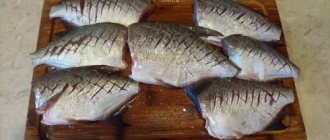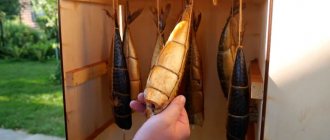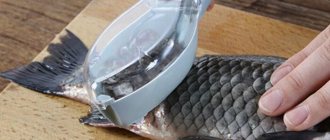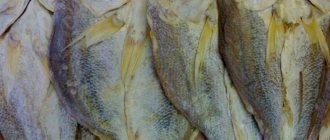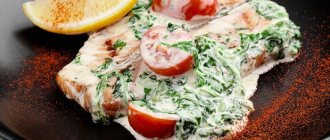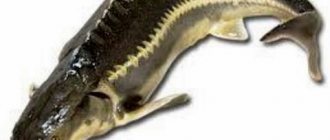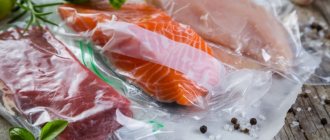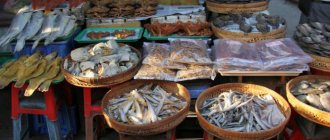Dried fish is sold in many retail outlets, but to be sure of the quality of the product, it is best to make it yourself. To dry fish at home you don’t need to have any special skills; even a beginner can handle this simple process.
The taste of the finished product will depend not only on the cooking process. The quality of the finished product is affected by the size of the fish, fat content and fiber structure.
It is worth taking into account that drying is the process of drying fish carcasses with preliminary salting, which is mandatory for this method of preparation.
Selecting fish for drying
Craftsmen prefer to dry small, bony fish that you don’t want to fuss with in order to bake or fry. You can use larger carcasses, but it will take more time and labor.
It is optimal to choose for drying fresh sea, river, or lake fish caught no more than a day ago. Fresh frozen pink salmon, chum salmon, silver carp, and salmon are also suitable.
The most delicious are:
- vobla;
- chub;
- pink salmon;
- pollock;
- grayling;
- pike;
- herring;
- mackerel;
- crucian carp;
- perch;
- track;
- ide;
- white bream;
- silver bream;
- carp;
- tench;
- mackerel;
- whiting;
- vendace.
It is not recommended to dry rotan and gobies. These fish shrink greatly after drying, leaving only a dry skeleton with a small amount of meat fibers to eat.
Large dried fish
Oily fish is considered a delicacy; its meat is tender and tasty. But they dry it in small quantities so that they have time to eat it before an unpleasant odor and bitterness appear.
For long-term storage, lean fish is dried. Chekhon, bream, and sorog are ideal for this. Their nutritional value depends on the fishing season. If the white fish is caught in the fall, when it is fattening, it produces a ram with soft, juicy meat.
Soaking
It is necessary to soak the fish after salting. This will get rid of excess salt accumulated in the upper layers of the meat. This will increase the shelf life, since the dried skin will not allow moisture to be absorbed, and will also prevent salt stains from appearing on the carcass after drying.
First, all fish must be carefully washed under the tap, being careful not to damage the scales and skin. Soaking is required in a large container with clean cold water, which can be changed every hour to speed up the process. The duration depends on the size of the carcasses and the holding time in brine (about 1 hour will be required for each day).
When the fish starts to float, you can take it out. After drying, the meat of such a product will become amber in color, almost transparent, and the taste will be lightly salted.
It is necessary to calculate in advance how long to keep the fish in the water in order to prevent the top layer from getting wet, because this can spoil the product. This is especially true for very fatty fish, which is better to soak in several approaches, allowing it to drain and lie for the same period of time chosen for its presence in the liquid.
Choosing a salting method
It is impossible to dry carcasses without first salting them. This will lead to the development of pathogenic microflora (opisthorchiasis) and spoilage of the product. Fish is salted before drying in several ways (dry, wet, in brine).
For salting, use coarse salt. The fact is that fine salt penetrates into the spaces between the meat fibers, dehydrating them; the spice acts as a dehydrator. As a result, the meat will be tough. The wet method is best for salting small and medium-sized fish. For large specimens, dry salting is suitable. But if desired, any fish can be salted dry or wet.
Small fish are salted and dried whole (not gutted). This way they are soaked from the inside with fat and become amazingly tasty. Fish over 500 g are gutted.
Dry
In this way, before drying fish at home, it is advisable to salt large carcasses that weigh more than a kilogram. They are cleaned of their intestines, since in the summer the stomachs of predators may contain remnants of the previous meal and smaller fish. It is unlikely that it will be pleasant to eat such a “double delicacy” later. Therefore, they cut open the belly, carefully take out all the insides, and wash the carcass inside and out.
For salting, a wooden box is suitable, the bottom of which is lined with a clean cloth. It should have holes to drain excess moisture. For every 10 kg of catch, 2 kg of coarse salt is required. The carcasses are placed as close as possible, with their bellies up, and generously sprinkled with salt so that it completely covers them. Oppression is placed on top. As it salts out, the delicacy will thicken. When the backs become firm and there is no moisture left, the product is ready.
Wet
When salting, 1.5 kg of salt is required for every 10 kg of fish. Do not be afraid of over-salting; it is removed during the soaking process. For salting, the fish is thoroughly washed, small ones are not gutted, and the entrails of large ones are removed. Place in glass containers in several dense layers.
When salting using the wet method, 10 kg of fish need 1.5 kg of salt
Cover the top with gauze and apply pressure. This allows you to compact the salting and remove excess air. A supersaturated saline solution is prepared at the rate of 3 liters of water and 300 g of salt per kilogram of product (artificial brine). If desired, add a spoonful of sugar and any spices. They pour it over the fish without removing the oppression and gauze.
Provesny
A gentle salting method, suitable for fish with tender meat or a lot of fat. This is how herring, sardines, pink salmon, salmon, mullet, trout, and grayling are salted. For salting, choose a non-oxidizing container in which the fish can be placed freely in an upright position with its head. Prepare a saturated salt solution (300 g of salt per kilogram of fish) and pour it into a container. You will need long rods that are placed on top of the dishes. Uneviscerated carcasses are hung from the rods so that they do not touch each other and dipped in brine. The delicacy is salted for 5-7 days.
In brine
With this method of salting, carcasses are salted in a saturated brine consisting of their own juice and salt (natural brine). The bottom of the container is lined with polyethylene and sprinkled with a thick layer of salt. Place the fish sideways or belly up on a salt bed, tilted to one side, sprinkle with coarse salt so that it completely covers the entire product. The inside and gills are especially carefully salted. After this, a weight is placed to release the juice. The fish salted in this way is ready in a cool place. For small carcasses, 2-3 days are enough; large ones need to be salted for more than a week.
The salinity of fish in a raw or brine solution is determined using the following test. They take the carcass by the head and tail and begin to pull. If she is ready, a quiet cracking of the vertebrae is heard. Salted meat becomes dense.
Practical useful tips
When processing and storing their catch, experienced fishermen pay attention to details to make the process easier and more efficient:
- When salting, large specimens are placed on the bottom of the dish, and small ones on top.
- Carcasses of the same size are strung on one cord. Then it will be ready at the same time.
- To make drying at home faster, the bellies are opened by inserting toothpicks.
- In winter, they make a frame box for hanging. Together with the frame, the fish can be moved from place to place.
- From large, fatty specimens, balyk can be prepared by drying.
- If fish becomes damp and has a musty taste if stored improperly, it can be washed in a weak salt solution and dried again.
Drying fish is a simple and effective process. Over time, experience is gained that allows you to make the most of existing conditions and opportunities. You need to carefully monitor how the properties of fish change during drying. Then you will get a tasty and aromatic delicacy that can be served both at the holiday table and consumed at a warm friendly meeting.
In this video, an avid fisherman shares tips on how to properly dry fish.
Drying fish using household appliances
The best method of drying is considered to be drying in the open air. But you can properly dry fish at home in an oven, electric dryer, or drying cabinet. Such methods are suitable for small and medium-sized carcasses.
In the oven
The fish are dried at a temperature of 150-180 degrees in the oven. Then they wrap their heads in foil and leave them for another couple of hours. Then, for final readiness, they are hung on the balcony.
In an electric dryer
Place the carcasses on trays or electric dryer racks and turn on medium heat. Periodically, the electric dryer is turned off to prevent the delicacy from overdrying.
What is drying?
Dried fish is a fish that, after pre-salting, is dried under natural conditions.
Slow drying in the open air or in a well-ventilated area changes the properties of the fish and gives it a sharp, piquant taste. This process is also called drying.
Slow dehydration in combination with environmental influences leads to gradual ripening of meat:
- Protein tissues are saturated with fat and become dense and elastic.
- The pulp appears translucent and acquires a beautiful amber color.
- Caviar turns into a particularly tasty grainy delicacy.
Overall, the savory taste and pungent spirit of dried fish is unique and easily recognizable. The silky skin with silvery scales is easy to remove, and the salty strips of meat can be eaten.
What kind of fish can you dry at home?
Not every fish gives good results when dried and dried.
You need to choose varieties whose meat is able to ripen properly, acquiring the specific consistency and smell characteristic of a dried product.
Small species, which are considered of little value in industrial fishing, have an excellent taste when dried. These are roach, ram, saberfish, silver bream and other species belonging to the so-called partial ones. Of the larger ones, we can recommend bream, pike perch, and catfish.
The best quality is fresh fish, salted on the day of fishing. A catch that was stored in an insufficiently cold place may already turn out to be “smelly.” This “bear-style” drying is popular among northern peoples, but unaccustomed people may not like this result.
Sometimes frozen and then thawed fish are dried. It is recommended to buy mackerel, herring, flounder, and halibut. You can also freeze your own catch for later drying.
The tastiest fish is medium to high fat content. Its quality greatly depends on the time of year. Before spawning, the fat content is higher, so catch made in early spring or winter is recommended for drying.
Features of drying in winter
Fans of fishing in winter frosts properly dry their fish at home, even during the cold season. The salting technology is similar to the summer one, but the drying process itself occurs only in the kitchen or closed, heated balconies (loggias).
In indoor conditions, fish garlands are hung in the kitchen above the gas stove, almost under the ceiling. It is important that there is good ventilation of the room. Open windows or vents daily for ventilation.
On the loggias they simply string ropes or wires, hang the carcasses and open the windows slightly. The advantage of winter drying is the absence of flies at this time, so the catch does not need protection. The main disadvantage is the length of the process.
Brine recipe
To salt fish, you will need to make a brine, in which you need 350 grams of table salt per liter of water.
The brine is given time to settle until transparent.
For flavor, add a bay leaf, a few peas of allspice and black pepper, a few clove inflorescences, and a dessert spoon of mustard seeds.
These spices will add flavor to the fish and make its smell more attractive. Utensils for salting fish should be enameled, ceramic or stainless steel.
Soaking
You have already noticed how much salt is needed for drying. You will have to get rid of the excess, otherwise it will be impossible to eat.
How to do it:
- Remove the fish from the salt.
- Leave for 60 minutes.
- Wash in clean water.
- Skim off the mucus.
- Pour cold water into a container and place the product there.
- Don't forget to change the water.
- As soon as the fish float to the surface, take them out and lay them out on paper.
- You can start drying.
Storage of the finished product
Everyone dries the semi-finished product to their taste: some like slightly dried meat, others like it almost wooden-like. In this regard, drying times vary significantly, but rarely does anyone hang carcasses for longer than 5-7 days.
The scales of the finished fish are slightly shiny with fat, but no salt crystals appear on them. The skin is thick, but comes off relatively easily. The meat is elastic and dense, translucent, with a characteristic spicy taste, without bitterness or signs of mold.
In fact, dried fish of this condition, already removed from the wire, is ready to become an original delicacy, but connoisseurs recommend bringing it to perfection in a cool place, wrapping it in culinary parchment or placing it in a linen bag.
Dried whole
Fans of dried fish should also try the version made from pink salmon. Her meat is tender and flavorful.
Cooking time: 14 hours.
Cooking time: 14 days.
Number of servings: 8.
Calorie content per 100 g:
- U 18.4;
- F 2.9;
- B 3;
- K 111.9.
Ingredients:
- pink salmon – 1 kg;
- salt -3 tbsp. l;
- sugar – 1 tbsp. l;
- bay leaf – 3 pcs.
Preparation:
- Remove the head from the pink salmon and remove the entrails.
- Finely chop the bay leaf and combine with salt and sugar.
- Rub the prepared carcass with the mixture on all sides and leave overnight.
- In the morning, wash the fish. To prevent the sides from sticking together and to dry the fish from the inside, you need to insert skewers or toothpicks into the abdominal part.
- Hang pink salmon to dry in a ventilated area. After 7 days, the skewers can be removed from the peritoneum. 2 weeks after hanging, dried fish can be eaten.
